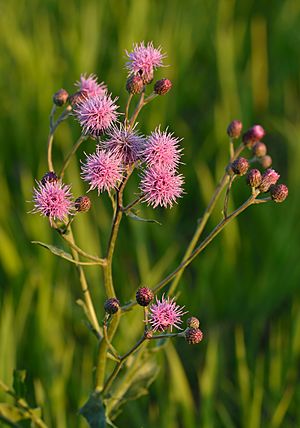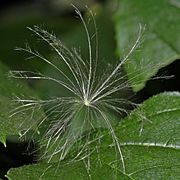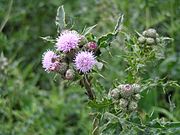Canada thistle facts for kids
Quick facts for kids Canada thistle |
|
|---|---|
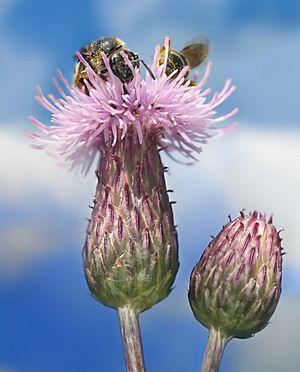 |
|
| Scientific classification | |
| Genus: |
Cirsium
|
| Species: |
arvense
|
Cirsium arvense is a type of flowering plant in the daisy family, Asteraceae. It originally comes from Europe, western Asia, and northern Africa. Today, you can find it in many other parts of the world because it has been introduced there. In Europe, it's commonly called creeping thistle. In places like the United States, it's often known as Canada thistle or field thistle.
This plant is very helpful for insects that collect nectar, like bees. It produces a lot of sweet nectar, making it a great food source for many pollinators.
Contents
What are its other names?
People use many different names for this plant, depending on where they are or what they used to call it. Some of these names include Canadian thistle, lettuce from hell thistle, California thistle, corn thistle, cursed thistle, green thistle, hard thistle, perennial thistle, prickly thistle, small-flowered thistle, and stinger-needles. Even though it's called "Canada thistle" in the United States, it didn't actually come from Canada!
What does it look like?
Creeping thistle is a herbaceous (meaning it has soft stems, not woody ones) plant that lives for many years. It can grow up to 150 centimeters (about 5 feet) tall. This plant spreads easily by sending out many shoots from its thick roots, forming large groups of plants that are all connected underground. It's a very adaptable plant that can grow in disturbed areas.
Because it can adapt so well, creeping thistle is considered one of the worst invasive weeds around the world. It can even change its genes to better suit the place where it grows. This helps it deal with different stresses, like harsh weather, and even change when it blooms.
How does it grow underground?
The underground part of the creeping thistle is quite complex. It has four main types of structures:
- Long, thick roots that grow sideways.
- Long, thick roots that grow deep down.
- Short, thin shoots.
- Vertical stems that stay underground.
These roots help the plant spread far and wide. New shoots can grow from buds on these thick roots. If you cut the shoots, new ones can also grow from the underground parts of the stems.
What about its stems and leaves?
The stems of the creeping thistle are usually 30 to 150 centimeters tall. They are slender, green, and branch out a lot. They are smooth and don't have any hairs or a waxy coating. The leaves grow one after another along the stem. They are very spiny and have deep lobes. They can be up to 15-20 centimeters long and 2-3 centimeters wide, getting smaller higher up the stem.
Why do its flowers smell?

Every plant has its own special flower smell. The scent of creeping thistle flowers attracts both pollinators (like bees) and insects that eat plants (like beetles). Honeybees, along with other types of bees and hoverflies, are often seen visiting these flowers.
The smell contains special chemicals that attract these insects. For example, a chemical called P-anisaldehyde is found in tiny amounts, but it's very attractive to honeybees. This shows that even small amounts of certain chemicals can make a big difference when mixed with others. After a flower has been pollinated, its scent often becomes weaker. This helps the plant save energy and tells pollinators to visit other flowers that still need to be pollinated.
The flower's fragrance is also very appealing to butterflies. Their antennae are very sensitive to the chemicals in the scent, especially phenylacetaldehyde and certain terpenes. This strong smell helps guide butterflies to the flowers, encouraging them to feed and help with pollination.
Flowers and seeds
The flowers of the creeping thistle grow in small clusters, usually pink-purple, and are about 10-22 millimeters across. Unlike some other flowers, all the tiny flowers within the cluster look similar. Most creeping thistle plants have separate male and female flowers, but sometimes a plant might have both.
The seeds are small, about 4-5 millimeters long. They have a feathery top called a pappus, which acts like a parachute and helps the wind carry them far away. Each branch can have 1 to 5 flower heads, and a plant in good conditions can produce up to 100 flower heads. Each head has about 100 tiny flowers. On average, one plant can produce about 1,530 seeds. More seeds are made when male and female plants are close together, as insects are important for moving pollen between them. Seeds can sprout the year after they are produced.
Different types of creeping thistle
There are different types, or varieties, of creeping thistle. These varieties are often identified by how their leaves look, such as if they are hairy, how they are shaped, or how spiny they are.
For example, in Northwest Europe, there are two main varieties:
- Cirsium arvense var. arvense: Found in most of Europe. Its leaves are smooth or only slightly hairy underneath.
- Cirsium arvense var. incanum (Fisch.) Ledeb.: Found in Southern Europe. Its leaves are very hairy underneath.
Other lists of varieties might include:
- Cirsium arvense var. vestitum: Has gray, woolly leaves underneath.
- Cirsium arvense var. integrifolium: Has leaves that are mostly smooth-edged.
- Cirsium arvense var. horridum: Has thick, wavy leaves with long, strong spines.
How it fits into nature
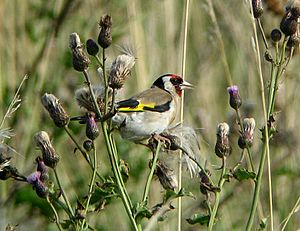
The seeds of the creeping thistle are an important food source for birds like the European goldfinch and the linnet. Many different insects also eat the plant's leaves, including over 20 types of Lepidoptera (butterflies and moths), such as the painted lady butterfly and the engrailed moth. Several types of aphids also feed on it.
The flowers attract many kinds of insects, including bees, moths, wasps, and beetles, all of whom help to pollinate the plant.
Why is it considered a weed?
Even in places where it naturally grows, creeping thistle is often seen as a weed. For example, in the United Kingdom, it's called an "injurious weed" by law. It's also a serious invasive species in many other countries where it has been accidentally introduced, often by mixing with crop seeds. Countries like Australia, Brazil, Canada, Ireland, New Zealand, and the United States consider it a "noxious weed." This means it's a harmful plant that needs to be controlled. Many countries even have rules about its seeds not being allowed in imported grains or other products.
How to control it
People use different methods to control creeping thistle, especially because it can spread so easily.
Natural ways to control it
One way to control it is by cutting the plant's flower stems before the flower buds open. This stops new seeds from spreading. If you keep cutting the plant at the same stage for several years, it can weaken the plant over time.
Growing certain crops, like alfalfa, can also help. When alfalfa is cut often to enrich the soil, the thistle weeds also get cut. This makes it harder for the thistle to grow back strongly, reducing how many shoots appear.
Some insects are used to control the thistle. For example, a fly called Orellia ruficauda lays its eggs in the thistle's flower heads. The larvae (young flies) eat the seeds, which helps reduce the number of new thistle plants.
Another insect, a weevil called Larinus planus, has also been used. One larva of this weevil can eat almost all the seeds in a flower bud. However, this weevil can also harm other types of thistles, including some rare ones, so it might not always be the best solution.
Certain types of rust fungi, like Puccinia obtegens and Puccinia punctiformis, can also help. These fungi cause a disease in the thistle that can eventually kill the plant. Scientists have found ways to easily spread these fungi, which can be a long-term, natural way to control the thistle without using chemicals. Studies have shown that these fungi can significantly reduce thistle numbers over a few years.
A tiny mite called Aceria anthocoptes also feeds on creeping thistle and is being looked at as a good natural control agent.
Chemical ways to control it
Farmers sometimes use special chemicals called herbicides to control creeping thistle. In the 1950s, herbicides with chemicals like MCPA helped reduce thistle problems in Sweden. MCPA and clopyralid are approved in some areas. Glyphosate is another herbicide that can be used when the plant is a few inches tall. The plant's leaves absorb the chemical, which then kills the plant.
In tests done in 2012, a herbicide called Prepass was found to be very good at controlling creeping thistle in alfalfa fields, while not harming the alfalfa crop itself.
What is it used for?
Like other plants in the Cirsium group, the roots of the creeping thistle can be eaten, but they are not commonly used. They can sometimes cause gas in people. The main root is thought to be the most nutritious part. The leaves are also edible, but their spines make them too difficult to prepare for food. The stems, however, are easier to prepare and can also be eaten.
Interestingly, a distillery on the Isle of Islay in Scotland uses creeping thistle as one of the 22 plant ingredients in their gin called "The Botanist."
The feathery pappus from the seeds has also been used by the Cherokee people to fletch (add feathers to) darts for blowguns.
See also
 In Spanish: Cirsium arvense para niños
In Spanish: Cirsium arvense para niños


